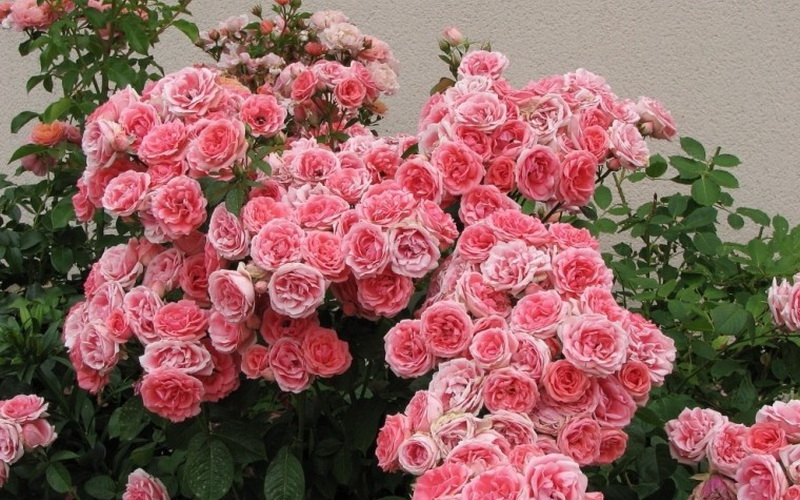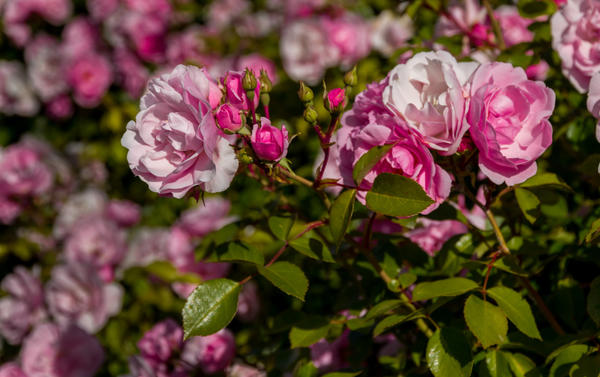Content:
What is a floribunda rose? This is a group of amazing varieties of roses. Bushes delight with their dense flowering over a long period: some varieties bloom continuously, some flowers are replaced by others. From Latin "floribunda rose" is translated as "profusely blooming rose". And these plants correspond to the given name.
Historical reference
According to some sources, the first floribunda variety was bred at the end of the 19th century. In 1880, Peter Lambert crossed polyanthus and tea roses by the breeding method, which resulted in the first variety.
According to other sources, only at the beginning of the 20th century, namely in 1924, the Danish originator Poulsen crossed the hybrid tea and polyanthus species.
Later, by combining hybrid tea, hybrid polyanthus, musk and other types of roses, many varieties were bred, which were later combined under the name "floribunda rose".
A large role in the formation of the group of varieties is assigned to Eugene Berner, who was nicknamed "the father of floribunda" for the fact that he created more than 60 varieties of this species. And it was his company that coined the term “floribunda”.
Feature and Description
The class includes low (up to 0.4 m), medium (up to 0.8 m) and tall varieties (over 1 m).
Flowers with a diameter of 4-8 cm have a wide variety of colors, there are also striped ones, some varieties are even superior in color brightness to hybrid tea. Flowers can be simple, semi-double, strongly double, with a variety of shapes from flat cupped to goblet. After the flowers wither, the roses will shed their withered buds on their own.
The disadvantage of floribunda varieties is a weak aroma or lack thereof.
Place in landscape design
For landing, an open spacious area is selected. Do not plant more than 2-3 bushes per 1 m².
Low-growing shrubs are great for creating curbs, decorating garden paths and paths.
Taller roses look spectacular both in hedges and in single plantings in the open field or bulk pots. Various ground cover plants and herbaceous perennials are excellent companions for creating a group composition.
They perform well after cutting, so they can often be seen in gift bouquets and even in wedding decor.
Class difference
Floribunda is less demanding in care than a hybrid tea rose, not so whimsical in the choice of soil and climatic conditions, has a longer flowering period and a huge variety of shapes, sizes, colors. It has rather flexible stems, so it does not need pruning before the frost season (when covered, it is simply bent to the ground and fixed), unlike tea roses. It is also characterized by increased resistance to frost and attacks of pests and diseases.
Floribunda differs from polyanthus in the size of buds. It has larger flowers, but loses in size to hybrid tea varieties.
Variety of varieties
Top 10 most common varieties:
- Lilli Marleen is a bush about 0.7 m high.The leaves are smooth, green with a touch of bronze. The flowers are slightly double, medium-sized, bright scarlet, with a subtle scent.
- Stromboli is an upright shrub, reaching a height of 0.8 m. The crown consists of smooth dark green leaves. The inflorescence includes 3-10 cup-shaped, double flowers of bright red color with a weak odor.
- Sangria is a relatively recently bred variety (2000). The difference between the Sangria rose and the rest is the bright buds of the color of ripe raspberries, the petals of which are located in two tiers. The size of the lower ones is 6 cm in diameter, the upper, medullary, pointed at the ends, densely collected - 3 cm. The brightness of the color remains throughout the season.
- Friesia. Rose Freesia has shoots that fit tightly to each other, reaching a height of 0.7 m. The aroma is well expressed, the flowers are double, bright yellow, do not fade even with constant exposure to sunlight. Blooms relatively early, pleases with flowering until the onset of cold weather.
- Diadem are undersized bushes. The cup-shaped flower consists of densely double petals. On average, 4-5 buds grow on one branch. At the beginning of flowering, the color of the buds is pale pink, gradually fading under the influence of sunlight and turns into a milky white.
- Kosmos are tall-growing roses, reaching 1.2 m. The cup-shaped buds of the Cosmos rose are composed of creamy white double petals and have a subtle scent.
- Pastella is a branchy variety 0.6 m tall. Rosa Pastella has cluster inflorescences, in which there are from 3 to 8 creamy pink cupped flowers with a spicy aroma.
- Novalis - re-blooming roses, with a shoot height of 0.9 m. Up to 3 dark-lilac cupped densely double flowers grow on one stem. Rose Novalis has a subtle scent.
- Acropolis is a unique variety. The height varies from 0.6 to 0.8 m. The double pink buds of the Acropolis rose bloom and acquire a coffee-brown color with a greenish tint.
- Shocking Blue. The roses in the brushes have 3-9 flowers of a fuchsia or lily shade, due to the play of light, they seem to be dark purple or purple. The Shocking Blue rose is grown under the cut because of its long stems.
These are not all varieties. For example, the Ebb Tide rose stands out due to its pronounced scent and smoky purple color. The purple rose of Deutsche Welle is very beautiful. Florists often prefer bushes with red (Lavaglut rose or Tornado rose) or yellow flowering (China Girl rose or Lampion rose). The Waikiki rose looks great on the site because of its warm pink color or the Baylando rose with delicate light pink petals. And the rose of Camille Pissarro has a unique brilliance, its flowers resemble a palette, because the flower combines red, pink, yellow, white colors at once. The list of varieties is huge and will be replenished every year.
Disembarkation and follow-up care
The most suitable period for disembarkation is May - June. Florists of warm climatic zones can plant seedlings in the first half of autumn.
Preference should be given to an area without drafts and with periodic access to sunlight. That is, the bushes can be in the sun for part of the day, but in the afternoon they should be slightly shaded, otherwise constant exposure to direct sunlight will lead to the burning of flowers.
You should pay attention to soil preparation:
- Clay soil should be thinned with the same amount of compost and yellow or gray river sand.
- Too sandy soil can be diluted with clay and humus in equal parts.
- The earth can be saturated with bone meal and a small amount of superphosphate (about 30-40 g per well).
- You can start preparing the substrate in advance. To do this, combine garden or vegetable garden soil, clay, peat, sand, humus in equal proportions and add a handful of bone meal and superphosphate.
Step-by-step instructions for planting seedlings of floribunda rose varieties:
- Cut off rhizomes and shoots. The length of the root processes after pruning should not exceed 30 cm, branches - 35-40 cm.
- A day before planting, immerse the plant's root system in water. You can add an agent to stimulate root growth, for example, Kornevin, Kornerost, etc., to the water. The dosage indicated on the package should not be exceeded.
- Dig holes according to the number of seedlings. Their depth should be about 30 cm, dimensions - 50 × 50 cm. You should independently adjust the size depending on the volume of the root system.
- Pour water into the hole, add the prepared substrate after absorption.
- Place the roots in the hole, cover, tamp lightly. The distance between the ground and the vaccination site should not be less than 2 cm.
- Water abundantly, after soaking, sprinkle with earth.
- A layer of peat, humus or sawdust mulch can be placed on top.
Aftercare is quite laborious. Frequent abundant watering is needed. In the summer heat, under each bush, it is necessary to pour 10 liters of water 1-2 times a week. With the arrival of autumn, the amount of water and the frequency of irrigation are reduced.
With the onset of the active growth phase, nitrogen fertilizers or mullein should be applied. It is necessary to regularly loosen the soil, remove weeds, mulch, and also be sure to carry out formative pruning during the growing season. Giving the correct shape to the shrub, it will be necessary to shorten the side branches and shoots so that after that there are 6 buds on them, and also to remove the dried and damaged stems.
Prevention and treatment of diseases, protection from pests
Relatively young, recently bred varieties are 2-3 times more resistant to disease than older varieties, which are often subject to diseases of powdery mildew, rust, gray mold and leaf spot.
To protect the plant, growers with experience spray garlic, onion or tobacco decoctions on the bushes, or use purchased synthetic products.
The disease prevention procedure is carried out in the evening or in the morning after the dew has melted. Before processing, the roses are watered.
Before cold weather, the bushes must be treated with a solution of copper sulfate, and with the onset of spring - with copper oxychloride.
If the measures taken did not help and the fungus affected the plant, all affected branches should be cut off. Collect cut shoots, fallen leaves and petals, weeds growing nearby and take them outside the garden, or better burn them altogether. Treat the plant with vitriol or Bordeaux liquid.
The floribunda class is also susceptible to attacks by harmful insects: spider mites, aphids, rose sawfly, rose leafhopper, leafworm. Ready-made chemical compositions that are sold in hardware garden stores will help in the fight against them.
The floribunda class surprises with its range of varieties. Even the most scrupulous grower will find his own variety that meets all the requirements. Floribunda has a lot of advantages, including unpretentiousness and increased winter hardiness. Therefore, these roses will be an excellent garden decoration in a wide variety of climatic zones.

















